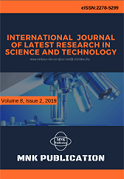DOI:10.29111/ijlrst ISRA Impact Factor:3.35, Peer-reviewed, Open-access Journal
Research Paper Open Access
International Journal of Latest Research in Science and Technology Vol.4 Issue 2, pp 46-55,Year 2015
Correspondence should be addressed to :
Received : 05 April 2015; Accepted : 08 April 2015 ; Published : 30 April 2015

| Download | 125 |
|---|---|
| View | 179 |
| Article No. | 10490 |
Cements based on synthetic calcium sulfate is among the most investigated material for dental and orthopedic applications in reconstructive surgery. To overcome the short-term cytotoxic effect, brittleness and fast resorption of calcium sulfate dihydrate(CSD), as bone substitute material, CSD was doped with Lepidium sativum water extract(LS) powder and mixed with cow bone mineral (BM) (1: 0.04: 1: wt/wt ratio respectively). The Fourier Transform Infrared (FTIR) spectra of BM-CSD, BM-CSD-LS, and BM-LS composites, compared to BM, were recorded. LS was analyzed by using Gas Chromatography/ Mass Spectroscopy(GC/MS) and Scanning Electron Microscope-Energy Disspersive X-ray(SEM-EDX). The results revealed that the total carbonate/phosphate ratio, type B-carbonate substitution, and acid phosphate content increased dramatically in all tested composites, the maximum increase was detected in BM+CSD+LS composite. Other forms, rather than B-carbonate substitution, takes place such as substitution with Zn, Mg and amino acids. The BM-crystallinity (BMC) decreased significantly in both BM+CSD, B+CSD+LS while, it is slightly decreased in BM+LS composite compared to BMC. Thus, addition of CSD to bone mineral leads to decrease in crystallinity while adding LS only or doping CSD with LS increases the crystallinity of bone mineral compared to BM+CSD composite with increasing in the apatite crystal size and the acid phosphate content as well.
Copyright © 2015 Gehan A. Raouf et al. This is an open access article distributed under the Creative Commons Attribution 4.0 International (CC BY 4.0) license which permits unrestricted use, distribution, and reproduction in any medium, provided the original work is properly cited.
engineering of bone. Tissue Engineering. 6, 361-381.
Gehan A. Raouf,Hana Gashlan, Alaa Khedr, Salem Hamedy, Hind Al-jabbri , " In Vitro New Biopolymer For Bone Grafting And Bone Cement ", International Journal of Latest Research in Science and Technology . Vol. 4, Issue 2, pp 46-55 , 2015

MNK Publication was founded in 2012 to upholder revolutionary ideas that would advance the research and practice of business and management. Today, we comply with to advance fresh thinking in latest scientific fields where we think we can make a real difference and growth now also including medical and social care, education,management and engineering.

We offers several opportunities for partnership and tie-up with individual, corporate and organizational level. We are working on the open access platform. Editors, authors, readers, librarians and conference organizer can work together. We are giving open opportunities to all. Our team is always willing to work and collaborate to promote open access publication.

Our Journals provide one of the strongest International open access platform for research communities. Our conference proceeding services provide conference organizers a privileged platform for publishing extended conference papers as journal publications. It is deliberated to disseminate scientific research and to establish long term International collaborations and partnerships with academic communities and conference organizers.